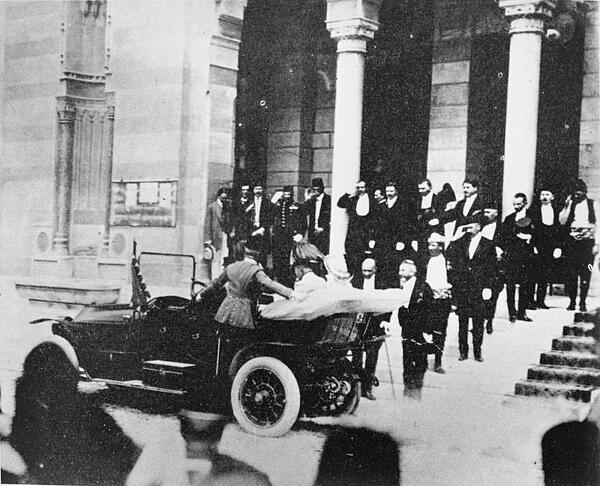Assassination at Sarajevo
The assassination of Franz Ferdinand in Sarajevo was the immediate cause of World War One. Europe had become a ‘powder keg’ by 1914 and the assassination was the spark that ignited these tensions.
On 28 June 1914, the heir to the Austrian Empire, Archduke Franz Ferdinand, was visiting the city of Sarajevo, Bosnia’s capital.
At this point tensions in Bosnia were high. There was an increasing sense of nationalism, which was embodied in the ‘Black Hand’ movement. These nationalists wanted independence from Austria-Hungary and were willing to use terrorist tactics to achieve this goal.
The Archduke was warned that the the trip may provoke violence. Serbian nationalists viewed the visit as provocation. The visit was a way of showing off Habsburg rule and it was seen as a provocation by Serbian nationalists. But he decided to go ahead with the visit.

There had already been problems at the beginning the royal tour when a grenade his another in the entourage.
However, Franz Ferdinand wanted to continue, albeit on a route away from the city centre. However, this message was not communicated to the driver who continued through the centre.
The driver tried to reverse out onto the main streets after pausing to check where he was. The car stopped five feet from Gavrilo Princip, one of the assassins from the Black Hand. Princip shot the Archduke in the head and his wife in the abdomen. They both died shortly afterwards.
A photographer captured one of the most infamous scene from the assassination. If it wasn’t for the pre existing tensions in Europe, the assassination would never have led to war.
Serbia was blamed by Austria for this murder. Serbia was intent on liberating Bosnia from Austro-Hungarian rule and forming a unified Serbian state. Therefore, she had encouraged the actions of the Black Hand.
Austria planned to invade Serbia as punishment. Serbia called on Russia for help. Russia had a large Serbian minority and many ties with the Balkan region so and she agreed to join Serbia if Austria-Hungary attacked.
Although Serbia would have been easy for Austria to defeat, Russia was much larger and stronger. The Triple Alliance of 1882 meant that Germany had already promised to support Austria in the event of war. Germany became allied with Austria, which in turn provoked the French government.
However, decades earlier the German army had created a plan called the Schlieffen Plan. This was a strategy to allow Germany to fight a war on two fronts - in France and Russia. This plan assumed that the Russian army would take six weeks to mobilise itself. During that time, Germans could launch an attack on the French and then fight the Russians.
Germany carried out the Schlieffen Plan when France mobilised her army. They proceeded to attack France via Belgium.
At this point Britain entered the war. Britain had promised Belgium protection in 1838, so she had little choice.
Due to a combination of alliances, imperialist ambitions and rising tensions, the assassination at Sarajevo triggered the outbreak of war in August 1914.
On 4 August 1914, Britain declared war on Germany after the German invasion of Belgium. France and Russia allied with Britain and Austria supported Germany.
Every country concerned was convinced that the war would be over by Christmas. Nobody could imagine the horrors of trench warfare.
See also: The Black Hand Movement
MLA Citation/Reference
"Assassination at Sarajevo". HistoryLearning.com. 2026. Web.
